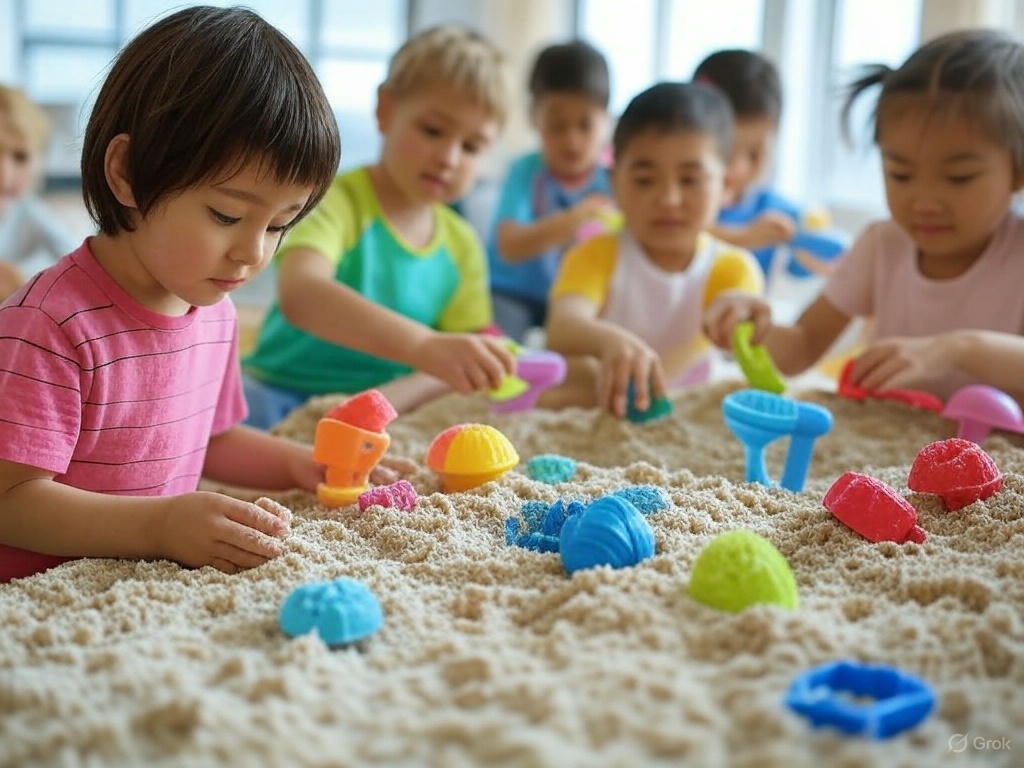Imagine a sandbox where the sand sticks to itself but never sticks to your hands. It flows like a liquid, molds like dough, and feels like a squishy dream. Welcome to the world of kinetic sand! This isn’t your ordinary beach sand—it’s a science-packed playtime superstar that’s taking over playrooms across the USA. So, what’s the secret behind this stretchy, squishy stuff? Let’s dig in and find out!
What Is Kinetic Sand?
Kinetic sand looks like regular sand but acts like magic. It’s made of 98% real sand (yep, the stuff you’d find at the beach) mixed with 2% of a special stretchy ingredient called polydimethylsiloxane. Don’t worry about pronouncing that—it’s just a fancy science word for a safe, stretchy goo that gives kinetic sand its superpowers. This mix makes it stick together so you can build towers, carve shapes, or even make pretend cupcakes without a mess!
Unlike regular sand, kinetic sand doesn’t dry out, and it’s soft as a cloud. You can squeeze it, pull it apart, and watch it “flow” like slow-motion water. Scientists call this a non-Newtonian fluid—a material that acts like both a solid and a liquid depending on how you play with it. Cool, right?
The Science Behind the Squeeze
Here’s where the fun gets brainy! When you grab a handful of kinetic sand and squish it, the tiny sand grains lock together thanks to that stretchy goo. It’s like the grains are holding hands—but only when you press them. Let go, and they relax, letting the sand flow through your fingers. This happens because of friction (the force that makes things stick or slide) and the goo’s special stretchiness. It’s science you can feel!

Want to test it out? Try this: Roll kinetic sand into a tight ball, then set it on the table. Watch it slowly flatten out like a pancake. That’s the non-Newtonian magic at work—solid one second, flowing the next!
Why Kids (and Scientists) Love It
Kinetic sand isn’t just fun—it’s a playground for your imagination and your brain. Here’s why it’s a hit:
- No Mess, All Fun: It sticks to itself, not your clothes or the floor. Cleanup is a breeze!
- Boosts Creativity: Build castles, sculpt animals, or invent your own gooey galaxy. There’s no limit to what you can make.
- Calms You Down: Squeezing and shaping kinetic sand feels so relaxing, it’s like a stress ball you can play with for hours.
Scientists even use materials like kinetic sand to study how things move and stick together. So when you’re playing, you’re experimenting like a real researcher!
Kinetic Sand Activities to Try at Home
Ready to play? Here are three awesome ideas to get started with kinetic sand:
- Volcano Blast: Mold a volcano with kinetic sand, then poke a hole in the top. Pour in a little baking soda and vinegar (ask an adult to help!) and watch it erupt. The sand holds its shape while the fizz spills over—science and art in one!
- Buried Treasure Hunt: Hide small toys or coins in a pile of kinetic sand. Use your hands or a spoon to dig them out. Can you find them all without the sand crumbling?
- Shape Challenge: Grab some cookie cutters and press them into the sand. Make stars, hearts, or dinosaurs—then see how long your shapes stay standing.
Fun Facts About Kinetic Sand
- It was invented by accident when scientists were trying to make a new kind of glue!
- Some kinetic sand glows in the dark—perfect for nighttime adventures.
- It’s safe for most kids to play with, but always check the package (and don’t eat it, okay?).
Where to Find It
You can grab kinetic sand at toy stores, craft shops, or online across the USA. It comes in all sorts of colors—blue, purple, even sparkly gold! Some sets include molds or tools to make your creations extra epic.
Why Kinetic Sand Rules
Whether you’re a kid who loves building, a dreamer who loves squishing, or a mini-scientist who loves experimenting, kinetic sand has something for you. It’s more than a toy—it’s a way to explore science, unleash your creativity, and have a blast without the mess. So next time you’re looking for an adventure, grab some kinetic sand and let your imagination run wild. What will you create?

